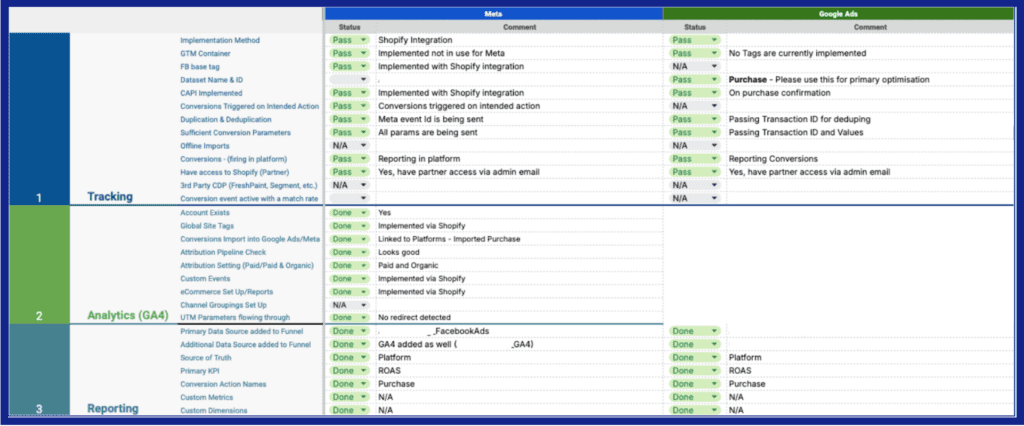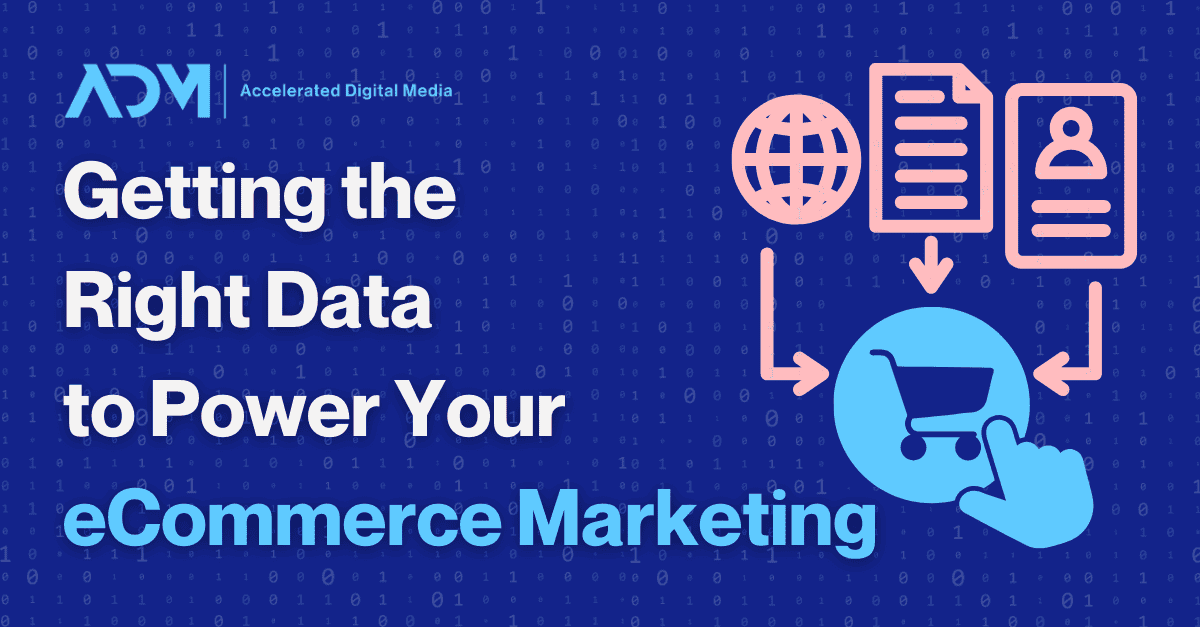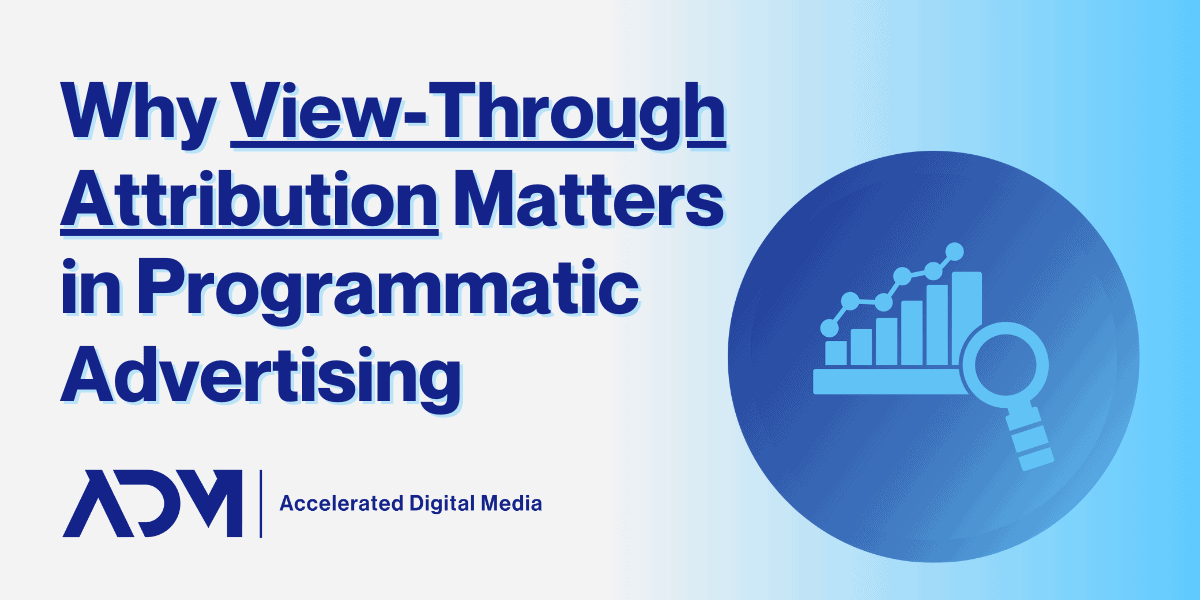Digital marketing revolves around data, but the data you need to acquire and analyze will depend heavily on your business goals. For direct-to-consumer eCommerce brands, it’s vital to optimize each of the steps from initial ad impression to final purchase. That process must be anchored in a clear understanding of your business priorities, event tracking and validation, and attribution.
By collecting the right data and knowing how to analyze it, brands can run smarter eCommerce marketing strategies that optimize each ad and channel to their fullest potential while improving customer experiences in ways that encourage new conversions. Recently, we’ve written about eCommerce marketing on Google Ads, eCommerce marketing on social media, and programmatic approaches to eCommerce marketing. In this blog, we’ll try to meticulously lay out what you need to know from a technical standpoint to get the best data insights from these channels.
What KPIs Best Dictate eCommerce Marketing Success?
eCommerce is reliant on digital marketing because of how visibly media spend can be translated into direct sales. The biggest advantage you’ll have will be knowing both the baseline and more in-depth metrics to base decisions off of. The basic building blocks are:
- Revenue
- ROAS (Return on advertising spend)
- CPA (Cost per acquisition)
- CAC (Customer acquisition cost)
- AOV (Average order value)
- LTV (Lifetime value)
These common KPIs can be taken steps further. Similar to ROAS in concept, MER (Marketing Efficiency Ratio), takes into account total company revenue divided by advertising spend. MER looks at the bigger picture by considering the total sales generated by all marketing efforts relative to the total marketing spend—not just digital advertising
MER provides a holistic view of the marketing efficiency across all channels. These distinctions are crucial, because while ROAS can give you a good idea of how specific campaigns are performing, MER offers insight into the overall effectiveness of your cumulative marketing strategy.
Using both metrics together can be informative. While we recommend leveraging ROAS at the more granular level for optimizations, MER serves as an important measure of health across all advertising efforts.
The deeper you go will depend on your business model. For all businesses, it’s crucial to differentiate New Customer Acquisition Cost versus total CAC to gauge the true cost of acquiring new customers by distinguishing them from returning customers. Prioritizing New Customer CAC comes down to accurate conversion tracking set-up, goals set within the accounts and bidding strategy levels, as well as campaign structures.
For subscription-based models, opt to view CAC based on LTV. LTV is the total value of your relationship with a customer over time, meaning it can complicate your CPA calculations slightly.
The appropriate LTV to CAC ratio varies based on factors like business model, industry, and growth stage. However, a common benchmark is a 3:1 ratio, meaning the lifetime value (LTV) of a customer should be three times the cost of acquiring them (CAC). For instance, if the LTV of a subscriber is $900, it would be reasonable to spend $300 to acquire that customer. If the customer pays $100 per month, this implies the average membership duration is 9 months ($900 ÷ $100/month = 9 months). In this case, the CAC would break even by month three, assuming no other costs are considered.
It’s important to note that not all businesses rely solely on subscriptions; some have a mix of one-time purchases and recurring subscriptions. In such cases, it’s crucial to set clear goals for each revenue stream and analyze them independently.
Knowing if You’re Tracking the Right Data
To know if you’re getting the right data for your eCommerce marketing strategy, it’s vital to take a hard look at every aspect of your existing implementations. That includes:
What events are being tracked—and should you be tracking more?
The events you track will make all the difference, which is why they’re the first thing to look at when evaluating an eCommerce account. At ADM, we typically ask questions like:
- Are basic conversion events set up for purchases?
- Can additional conversion events be set up through different stages of the purchase flow?
- Additionally, are there additional trackable events post-website interaction? These can include offline events, phone calls and store visits.
While we recommend optimizing towards purchases, building out additional events can provide further insight throughout the consumer journey to better understand conversion rates. Additional important events to track may include page views, steps within a quiz flow, and add-to-cart actions.
Are events firing accurately?
Every event that you’re tracking should be carefully validated. Run test purchases and closely document each event fire throughout the flow—both to confirm that intended events are firing, but also to map your conversion flow. Make sure the names of the actions are aligned across the ad platforms and any outside measurement tools.
Optimizing for the right events
Much of digital marketing today relies on allowing campaign algorithms to optimize their performance based on an intended result—meaning brands need to have a clear idea of what those results are. Typically for eCommerce brands, that event will be a final purchase action, but different business models or even business goals might dictate other needs.
The emphasis here is specificity. Something we often see in digital marketing audits is that an account will have a robust array of events built out—page view, add to cart, purchase, ettc.—but is optimizing towards all events. This inflates the conversion count and signals to platforms like Google that they can prioritize those less-valuable events, like a page view, because they’re easier to attain.
Are purchase events triggering the right revenue amount?
To get a real understanding of how digital marketing success equates to business success, you want to be tracking revenue as accurately as possible. That means assigning revenue values to certain events that the ad platform is optimizing for. In a straightforward eCommerce vertical like apparel, revenue is dynamically implemented to register the sale amount.
For subscription-based clients, ADM will work to determine what revenue amount should be attributed to the initial purchase based on lifetime value (LTV), average order value (AOV), and other factors. For brands that offer both subscription or one-time purchase options, there should be event tracking in place at time of checkout to help you understand the nature of the purchase.
There should also be event tracking in place to differentiate between new vs returning customers. This is important for brands that base their marketing on customer acquisition cost (CAC) goals vs. overall cost per acquisition (CPA) goals.
Tracking Implementation
Before launching any digital marketing campaigns, it’s essential to ensure proper tracking is in place. This not only helps with accurate performance measurement but also enables campaign optimization. Below are key tracking components to consider before hitting “go” on your campaigns.
Google Ads and Facebook Pixel Tracking
For most campaigns, if conversion events are being tracked then the answer will likely be “yes.” However, unless a specific use case or client need suggests otherwise, we recommend implementing both the Google Ads Tag and Facebook Pixel. These tools help optimize your campaigns by tracking user behavior and conversions across platforms.
To streamline tracking and reduce the need for constant code deployment, we recommend using a tag management solution like Google Tag Manager (GTM), Adobe Launch, or Tealium.
Enhanced Conversions in Google Ads
Have you enabled Enhanced Conversions within Google Ads? This feature improves the accuracy of your conversion tracking by enhancing your existing tags with hashed first-party customer data (like email addresses or phone numbers). This data is collected from website interactions and helps Google Ads better attribute conversions, boosting overall campaign performance, and we highly recommend it for getting the most out of your Google Ads account.
Conversion API (CAPI) for Social Platforms
For platforms like Facebook and TikTok, have you implemented CAPI (Conversion API)? Similar to Google’s Enhanced Conversions, CAPI increases the accuracy of conversion tracking by sending data server-to-server, bypassing browser limitations. This allows for more reliable tracking of events, including offline conversions, and can include first-party customer data.
Importing Offline Events and CRM Data
Are offline events, phone purchases, or CRM data being integrated into your ad platforms? While pixel and API-based tracking is critical, many clients are now uploading their own first-party data directly into platforms like Google Ads and Facebook. This includes offline conversions that are not directly captured by platform pixels.
Manual uploads, Google Sheets, and direct platform connections to systems like BigQuery, SnowFlake, Hubspot, and Salesforce allow for seamless data integration, further enriching your campaign’s performance insights.
Example Implementation Checklist:

Identifying Sources of Truth and Attribution
While in-platform metrics and data (Pixel events, CAPI, or first-party data) are essential for ad optimization, identifying your source of truth and attribution model is crucial for achieving aligned goals. Without clear agreement, campaigns can quickly become misaligned, leading to confusion and unproductive conversations.
At the start of every partnership, ADM determines what each client considers a successful outcome. For instance, what conversion event is used to measure CPA? Where is the conversion data coming from—ad platforms, GA4, or another third-party attribution platform? If one team reports 100 conversions in-platform while the client sees only 50 conversions in their source of truth, it’s clear that alignment is missing.
Attribution Beyond Ad Platforms
Increasingly, clients turn to third-party platforms or internal measurement tools to assess performance, rather than relying solely on ad platforms. While platforms like Google and Facebook tend to credit themselves for any conversion where the channel is involved, summing conversions across multiple platforms can create inflated totals.
Attribution is a complex and evolving space, and no method is 100% accurate. However, using tools like Multi-Touch Attribution (MTA) platforms, Incrementality platforms, or internal first-party data can offer deeper insights into the effectiveness of cross-channel marketing. These tools help deduplicate conversion totals and factor in variables like post-purchase survey data, A/B testing, and geographic testing, ensuring more accurate results.
Click Tracking and Parameter Management
Accurate reporting relies heavily on the tracking parameters attached to ad URLs. Whether using internal or third-party analytics tools, consistency and precision are key to obtaining meaningful data. Here’s a quick checklist for best practices in URL tracking:
- Use Dynamic Values: Whenever possible, use dynamic parameters for more granular data.
- Proper Syntax: Use ? at the end of a URL to start UTM parameters, and & between parameters.
- Consistency is Key: Consistent naming conventions help avoid fragmented data (e.g., “paid-social” vs. “social-cpc”).
- Lowercase Only: Keep UTM values in lowercase to avoid discrepancies.
- Use Dashes: Replace spaces with dashes to avoid URL encoding issues.
- Keep It Simple: Ensure naming conventions are straightforward and align with platform names to make data analysis easier.
Naming Conventions for Structured Testing
Clear naming conventions are also essential for organizing and optimizing ad campaigns. Structured naming helps in A/B testing, continuous optimization, and uncovering new growth opportunities. We review naming structures at the beginning of each partnership to align on goals, reporting, and testing frameworks for success.
Choosing the Right Analytics and Attribution Tools for eCommerce Marketing
Analytics and attribution practices need to constantly evolve alongside both technical capabilities and new privacy regulations. Tools that once provided comprehensive insights are now limited by:
- Apple’s Privacy Features: With Intelligent Tracking Prevention (ITP) and App Tracking Transparency (ATT), tracking iOS users has become increasingly difficult.
- New Privacy Laws: Regulations like CCPA complicate data collection and threaten traditional pixel tracking methods.
- Walled Gardens: Platforms like Facebook and YouTube restrict access to impression data, limiting the effectiveness of MTA.
- Growth in Non-Click Channels: Channels like Connected TV and Podcast advertising are growing in popularity, but don’t always offer direct-click tracking.
For Smaller Budgets: Google Analytics 4 (GA4)
For eCommerce brands with smaller budgets or single-channel advertising (e.g., Google Ads), we recommend using Google Analytics 4 (GA4) to monitor ad performance in relation to overall site behavior. GA4 is a free tool that offers valuable insights into ecommerce performance, conversion flows, and consumer behavior. However, it relies on last-click attribution, meaning higher-funnel tactics like social, display, or connected TV may not receive adequate credit.
For Multi-Touch Attribution: Rockerbox
For clients needing more comprehensive MTA capabilities, including non-click channels, we suggest exploring platforms like Rockerbox. Rockerbox leverages post-purchase survey data and view-based data to track conversions across multiple touchpoints. Importantly, it deduplicates conversions, ensuring that the total attributed conversions don’t exceed the actual number.
For Advanced Attribution: Incrementality Testing with Measured
For clients prioritizing investment and longer implementation, we recommend the incrementality method, which uses A/B testing and geo-testing to measure incremental conversions across channels. Our platform of choice for this method is Measured, which relies on Incremental Lift rather than pixel tracking. Measured’s approach makes it immune to industry shifts in pixel tracking, offering more robust insights at a higher cost.
Data Visualization & Structured Testing
Once tracking, attribution, source of truth, KPIs are aligned, it’s invaluable to build out real-time reporting in a performance dashboard. At ADM we like Looker Studio reports, which are specifically built to each client’s needs and ensure the client and team are viewing performance and optimization opportunities throughout the partnership. Custom dimensions and metrics, alongside structured naming conventions allow for efficient testing readouts and quick conclusions.
The Value (and Challenges) of Good Data Strategy
Brands should reevaluate their data practices frequently to ensure compliance with evolving privacy laws and to stay aligned with technological advancements.
But that isn’t always easy. Between confusion surrounding the removal of cookies, various 3rd-party attribution systems, and the continued trend towards use of first-party data within reporting and optimizations, it’s vital to always align on what you consider your source of truth and how your marketing agency can report and optimize off that source-of-truth data. This can occur through advanced tracking set-up, direct third party integrations, offline imports, etc.
A combination of consistent monitoring, adapting to internal changes, and responding to evolving industry standards will ensure data practices remain effective and compliant. From an optimization and monitoring standpoint, ADM views performance, budgeting pacing and account alerts at the daily and hourly level in some cases, to ensure constant reevaluation of the data coming in, as well as real-time data driven optimizations.
If you’re looking for a growth marketing partner that truly understands how to combat the challenges of a shifting eCommerce landscape, it may be worth reaching out to our team here at ADM for a full digital marketing audit or simple consultation.



